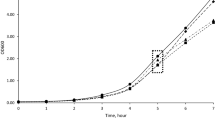Abstract
The dicarboxylic acids malate and fumarate increase ruminal pH, reduce methane production, increase propionate and total volatile fatty acid (VFA) production, and reduce lactic acid accumulation in a manner similar to ionophores. These acids stimulate the ruminal bacterium Selenomonas ruminantium to ferment lactate to produce propionate. Thus, dicarboxylic acids have been suggested as nonantibiotic modifiers of the ruminal fermentation, but their impact on ruminal microbial ecology remains unknown. This study was designed to examine what effects these modifiers may have on intestinal pathogen populations such as Escherichia coli O157:H7 and S. enterica Typhimurium prior to their widespread incorporation into cattle rations. Pure cultures of E. coli O157:H7 strain 933 and S. enterica Typhimurium were grown with malate and fumarate added at 0, 1, 5, 10, and 20 mM (v/v; n = 3). Neither dicarboxylic acid inhibited (p > 0.1) the growth rate or final populations of E. coli O157:H7 or S. enterica Typhimurium. Ruminal fluid was collected from cattle (n = 2) and E. coli O157:H7 and S. enterica Typhimurium were added to separate ruminal fermentations incubated for 24 h at 39°C. Fumarate and malate were added at concentrations of 0, 5, 10, and 20 mM (v/v; n = 2) and incubated for 24 h at 39°C. Malate or fumarate addition did not affect (p > 0.1) populations of E. coli O157:H7 or S. enterica Typhimurium. However, the final pH was increased (p < 0.05), the acetate:propionate ratio was decreased (p < 0.05), and the total VFA production was increased (p < 0.05) by ≥10 mM dicarboxylic acid addition. These results confirm that dicarboxylic acids can modify ruminal fermentation, but they do not affect populations of critical foodborne pathogens.




Similar content being viewed by others
References
Barkocy-Gallagher GA, Arthur TM, Rivera-Betancourt M et al (2003) Seasonal prevalence of shiga toxin-producing Escherichia coli, including O157:H7 and non-O157 serotypes, and Salmonella in commercial beef processing plants. J Food Prot 66:1978–1986
Bergen WG, Bates DB (1984) Ionophores: their effect on production efficiency and mode of action. J Anim Sci 58:1465–1483
Callaway TR, Anderson RC, Anderson TJ et al (2001) Escherichia coli O157:H7 becomes resistant to sodium chlorate addition in pure culture but not in mixed culture or in vivo. J Appl Microbiol 91:427–434
Callaway TR, Edrington TS, Brabban AD et al (2006) Fecal prevalence of Escherichia coli O157, Salmonella, Listeria, and bacteriophage infecting E. coli O157:H7 in feedlot cattle in the southern plains region of the United States. Foodborne Pathog Dis 3:234–244
Callaway TR, Martin SA (1996) Effects of cellobiose and monensin on in vitro fermentation of organic acids by mixed ruminal bacteria. J Dairy Sci 80:1126–1135
Callaway TR, Martin SA (1997) Effects of organic acid and monensin treatment on in vitro mixed ruminal microorganism fermentation of cracked corn. J Anim Sci 74:1982–1989
Castillo C, Benedito JL, Mendez J et al (2004) Organic acids as a substitute for monensin in diets for beef cattle. Anim Feed Sci Technol 115:101–116
Corrier DE, Nisbet DJ, Scanlan CM et al (1994) Inhibition of Salmonella enteritidis cecal and organ colonization in leghorn chicks by a defined culture of cecal bacteria and dietary lactose. J Food Prot 56:377–381
Cotta MA, Russell JB (1982) Effect of peptides and amino acids on efficiency of rumen bacterial protein synthesis in continuous culture. J Dairy Sci 65:226–234
Diez-Gonzalez F, Callaway TR, Kizoulis MG et al (1998) Grain feeding and the dissemination of acid-resistant Escherichia coli from cattle. Science 281:1666–1668
Edrington TS, Schultz CL, Genovese KJ et al (2004) Examination of heat stress and stage of lactation (early versus late) on fecal shedding of E. coli O157:H7 and Salmonella in dairy cattle. Foodborne Pathog Dis 1:114–119
Harris K, Miller MF, Loneragan GH et al (2006) Validation of the use of organic acids and acidified sodium chlorite to reduce Escherichia coli O157 and Salmonella Typhimurium in beef trim and ground beef in a simulated processing environment. J Food Prot 69:1802–1807
Hungate RE (1966) The rumen and its microbes. Academic Press, New York
Martin SA (1998) Manipulation of ruminal fermentation with organic acids: a review. J Anim Sci 76:3123–3132
Martin SA, Streeter MN, Nisbet DJ et al (1999) Effects of DL-malate on ruminal metabolism and performance of cattle fed a high-concentrate diet. J Anim Sci 77:1008–1015
Nisbet DJ, Martin SA (1990) Effect of dicarboxylic acids and Aspergillus oryzae fermentation extract on lactate uptake by the ruminal bacterium Selenomonas ruminantium. Appl Environ Microbiol 56:3515–3518
Nisbet DJ, Martin SA (1993) Effects of fumarate, L-malate, and an Aspergillus oryzae fermentation extract on D-lactate utilization by the ruminal bacterium Selenomonas ruminantium. Curr Microbiol 26:133–136
Nisbet DJ, Martin SA (1994) Factors affecting L-lactate utilization by Selenomonas ruminantium. J Anim Sci 71:1355–1361
NRC (2000) Nutrient requirements of beef cattle, 7th edn. National Academy Press, Washington, DC
Tejido ML, Ranilla MJ, García-Martinez R et al (2005) In vitro microbial growth and rumen fermentation of different substrates as affected by the addition of disodium malate. J Anim Sci 81:31–38
Van Immerseel F, Russell JB, Flythe MD et al (2006) The use of organic acids to combat Salmonella in poultry: a mechanistic explanation of the efficacy. Avian Pathol 35:182–188
Witte W (1999) Antibiotic use in animal husbandry and resistance development in human infections. APUA 16:1–7
Author information
Authors and Affiliations
Corresponding author
Additional information
Proprietary or brand names are necessary to report factually on available data; however, the USDA neither guarantees nor warrants the standard of the product, and the use of the name by the USDA implies no approval of the product, and exclusion of others that may be suitable.
Rights and permissions
About this article
Cite this article
Nisbet, D.J., Callaway, T.R., Edrington, T.S. et al. Effects of the Dicarboxylic Acids Malate and Fumarate on E. coli O157:H7 and Salmonella enterica Typhimurium Populations in Pure Culture and in Mixed Ruminal Microorganism Fermentations. Curr Microbiol 58, 488–492 (2009). https://doi.org/10.1007/s00284-008-9351-1
Received:
Revised:
Accepted:
Published:
Issue Date:
DOI: https://doi.org/10.1007/s00284-008-9351-1




